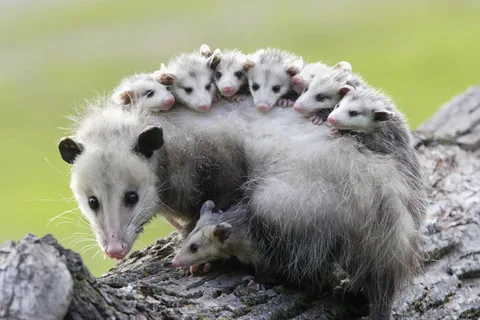The Magic of Tñacuache: A Traveler’s Guide

The tacuache, also known as the Virginia opossum in English, is a fascinating and often misunderstood animal native to the Americas. Frequently found in various regions, from dense forests to suburban backyards, the tacuache has adapted well to human environments, yet it remains an enigma to many people. This article will provide a thorough understanding of the tacuache, delving into its biological features, habitat, behavior, cultural significance, and the crucial role it plays in the ecosystem.
1. What Is a Tacuache?
The term tacuache is commonly used in Mexico and parts of Central America to refer to the Virginia opossum (Didelphis virginiana). It’s a nocturnal marsupial, meaning that the female carries and nurtures its young in a pouch, much like kangaroos. Although often perceived as pests, tacuaches play an essential role in the environment.
Characteristics
Tacuaches are known for their distinctive appearance, with greyish-white fur, a long, hairless tail, and a pointed snout. Adults typically weigh between 4 to 14 pounds and measure about 2 to 3 feet in length, including the tail. They possess sharp claws and opposable thumbs, allowing them to climb trees skillfully.
2. Habitat and Distribution Tñacuache
The tacuache is incredibly versatile when it comes to habitat. Found throughout North and Central America, their range extends from Canada down to northern Costa Rica. They thrive in a wide variety of environments, including forests, wetlands, and even urban areas.
Adaptability to Urban Areas Tñacuache
One of the reasons the tacuache has become so well-known is its ability to live near human settlements. In cities and suburbs, tacuaches can often be found scavenging for food in trash cans, gardens, and compost heaps. Their opportunistic feeding habits allow them to thrive in places where food resources are abundant.
3. Behavior and Lifestyle Tñacuache
Tñacuache are solitary creatures and mostly nocturnal, meaning they are active at night. They forage for food during the dark hours and rest in hollow trees, burrows, or abandoned animal dens during the day.
Omnivorous Diet
Tacuaches are omnivores, meaning they eat both plants and animals. Their diet includes insects, small mammals, fruits, and vegetables. Remarkably, they also consume ticks and other pests, helping to reduce the spread of diseases like Lyme disease in some areas. This dietary flexibility contributes to their success as a species in various environments.
Playing Dead
One of the tacuache’s most famous defense mechanisms is its ability to “play dead,” or go into a state called tonic immobility. When threatened, the tacuache can become completely limp, mouth open, and emit a foul-smelling odor, simulating death to deter predators. This involuntary response can last anywhere from a few minutes to several hours, depending on the level of threat.
4. The Importance of Tacuaches in the Ecosystem
Despite their reputation as pests, tacuaches play a vital role in maintaining the balance of ecosystems. They help control insect populations and dispose of carrion, effectively cleaning up the environment. Their consumption of ticks also contributes to public health by reducing the number of disease-carrying pests in their habitats.
5. Tacuaches and Human Interaction
Human interaction with tacuaches often leads to conflict due to their scavenging behavior. Many people see them as nuisances because they rummage through trash cans and gardens. However, their presence is beneficial, and in most cases, they pose little threat to humans or pets.
Misconceptions and Fear
Tacuaches are often the subject of misconceptions. Some people believe they are aggressive, rabid animals, but in reality, they are typically docile and prefer to avoid conflict. While tacuaches can contract rabies, they have a lower body temperature than most mammals, making them less likely to spread the virus.
6. Cultural Significance of the Tacuache
In various cultures, particularly in Central America, the tacuache holds symbolic importance. In folklore, they are often depicted as clever and cunning creatures. Some indigenous stories even portray them as tricksters or animals with magical properties.
Mythological and Folklore Representation Tñacuache
For example, the Aztecs believed that the tacuache was the animal responsible for bringing fire to humanity. In this legend, the tacuache stole fire from the gods and delivered it to humans, much like the Greek myth of Prometheus.
7. Conservation Status Tñacuache
The tacuache is not currently considered endangered. Due to their adaptability and broad geographic distribution, their populations remain stable in most areas. However, they face threats from habitat destruction, urbanization, and vehicle collisions, which are a leading cause of death for tacuaches in urban environments.
Environmental Threats
As urban areas expand, the tacuache’s natural habitats shrink, and they are forced to rely more on human settlements for survival. This shift increases the likelihood of negative human interactions, as well as exposure to dangers such as cars and domestic pets.
8. How to Coexist with Tacuaches
Given their important role in the ecosystem, it’s crucial to find ways to coexist with tacuaches rather than eradicate them. Here are a few simple measures to help ensure peaceful coexistence:
- Secure Garbage Bins: Use bins with tight-fitting lids to prevent tacuaches from scavenging for food.
- Remove Food Sources: Don’t leave pet food outside overnight, and ensure that compost bins are animal-proof.
- Provide Shelter: Consider offering safe, natural hiding places in your garden, like piles of wood or brush, for tacuaches to shelter in during the day.
9. Tacuaches as Pets: A Bad Idea
Although some people are tempted to keep tacuaches as pets due to their intriguing behavior and appearance, it’s not advisable. Tacuaches are wild animals and belong in their natural habitat. Their needs are complex, and they do not adapt well to life in captivity.
In many areas, it’s also illegal to keep opossums as pets without special permits, as they are considered wildlife. Additionally, they can carry parasites and diseases, making them unsuitable for household environments.
10. Tacuache Myths Debunked
There are several myths surrounding tacuaches that deserve clarification:
- Myth: Tacuaches are blind.
Reality: Tacuaches are not blind, though their vision is poor, especially in daylight. - Myth: They are dirty animals.
Reality: Tacuaches are surprisingly clean. They groom themselves regularly, much like cats. - Myth: Tacuaches attack pets and livestock.
Reality: Tacuaches are generally non-aggressive and prefer to flee or play dead when threatened by larger animals.
11. The Future of the Tacuache
As urbanization continues, the tacuache will undoubtedly face new challenges. Ensuring their survival means striking a balance between urban development and the preservation of natural habitats. Public education on the importance of tacuaches in the environment can help reduce fear and promote understanding.
12. Conclusion
The tacuache, or Virginia opossum, is a resilient and vital part of the ecosystems in the Americas. While often misunderstood, these animals contribute to pest control, disease prevention, and the overall health of their environments. By learning more about them and dispelling common myths, we can foster a better relationship with this remarkable marsupial.

